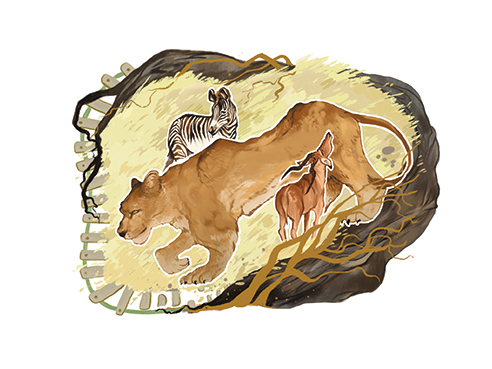An internet search for “Tsavo lions” will inevitably yield results of infamous “man-eaters” and the story of two lions that hunted railroad workers in the late 1800s along the Kenya-Uganda Railway. This grisly story, whose origins have been adapted into novels, films, and folklore, depicts a somewhat rare tendency of human-eating among Tsavo lions, while overshadowing their typical habits. Even today, little is known about these lions’ hunting and predation ecology, despite Tsavo—a region in southern Kenya—being a stronghold for these vulnerable cats in East Africa.
While it is home to approximately 450 lions, the Tsavo landscape also harbours two precious herbivore species introduced here in the 1960s as part of ambitious ex-situ conservation projects: the Critically Endangered hirola antelope (with fewer than 500 individuals remaining globally) and the Endangered Grevy’s zebra. Despite efforts to support their population recovery, both species have remained rare in Tsavo. Researchers have suggested that predation by lions and other carnivores might keep the somewhat localised hirola and Grevy’s zebra populations at low numbers. However, there is no conclusive evidence supporting this hypothesis.
To determine whether predation might take a toll on these two herbivores, and to gain a better understanding of lion diet and ecology in this landscape, between 2019 and 2023, we collected lion scats (aka poop) and identified undigested prey hairs in them to determine what species made up Simba’s menu. While such scat collection, curation, and sample identification is a painstaking and often smelly affair, when coupled with biomass models—a scientifically robust and widespread diet estimation technique—it can tell us not only what lions eat, but also how much!
We found that while Tsavo’s lions primarily feast on larger, more abundant species like Cape buffalo, giraffe, and waterbuck, they show a marked preference for the rare hirola and Grevy’s zebra. Together, these endangered species comprise about 5 percent of the lions’ diet—a significant proportion considering they represent just 1 percent of available prey in the landscape. This creates what ecologists call ‘apparent competition’, where abundant prey species maintain high predator numbers, inadvertently increasing pressure on rarer species. Think of it as an ecological trap: the success of common prey species keeps lion populations healthy, but this success might be hampering the recovery of endangered herbivores who are perhaps caught in a ‘predator pit’.
What does this all mean for the management and conservation of these two herbivores? Our study shows that lion predation may play a role in keeping the hirola and Grevy’s zebra populations at low numbers that were small populations to begin with; however, observational research with GPS telemetry on lions and other carnivores is needed to confirm these dynamics.
The story of the man-eaters of Tsavo will persist, but we hope that our study will pave the way for more directional research in this system to better understand carnivore-prey interactions in the wake of global climate change in this critical ecosystem.
Further Reading:
King E., S. Chakrabarti, F. Lala, S. Nyaga, G. Waiguchu, P. Chiyo, J. Kimaile et al. 2024. The Lion’s Share: Implications of a carnivore’s diet on threatened herbivores in Tsavo, Kenya. Oryx 58(4): 506–513. doi.org/10.1017/S0030605324000085.






